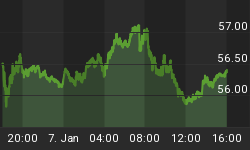It was quite a busy week, and I only had time to put up fragments of my analyses during the week. Now let me try to defrag - to organize and summarize - my commentaries.
On 4/3/2008, I'd expressed concern that my CMB (Composite Market Breadth) Volatility Index persisted at an unprecedented high level even though both the stock price based and the option price based volatility (VIX) indices had been declining - see my April 3- April 4 Market Breadth Divergence editorial for more details.
Blue circles on Chart 1 indicates peaks of the CMB Volatility Index correspond to lows of the market. The market began to rise when the CMB Volatility began to fall. This is because market dislikes volatility. The CMB Volatility normally tops out soon after it moves above 0.50. This is when short positions should be covered and long positions should be established. And, that's what had happened in mid March. The market hit bottom, bounced right back, and gained more than 7% through the first week of April. However, the CMB Volatility had also surged past the mid-March high during this same period (red arrows on Chart 1). That's clearly not a bullish sign.
One reason the market continued to fall since mid December is that the CMB Volatility had never declined below 0.40 (blue rectangular box). In order for the market to feel comfortable enough to begin a new uptrend, this CMB Volatility will have to begin to trend lower, not just zigzagging sideways as it did within the blue rectangular, or making new highs as it did recently.

Chart 1
Another disappointing technical development of late is the market's inability to hold on to its gains in the afternoon sessions. That's depicted on most charts with sprinkle of High Wave, Spinning Top, or Doji candlestick patterns following the big rally on the 1st day of April. It's also manifested on my Intraday Breadth Performance chart, which, by all means, measures intraday market breadth differentials (Chart 2 below).
On Friday, 4/4/2008, the Nasdaq Intraday Breadth Performance violated its 3/12/2008 low (red circle on Chart 2). It then went on to drop below zero on the very next trading session, Monday, 4/7/2008.

Chart 2
The late session decay can also be seen on the deterioration of the CLV (Close Value Location), which measures closing price's relationship to the trading range. Chart 3 below shows the decline of the Nasdaq 100 PowerShares (QQQQ) after its March 26 peak. And, just like the Nasdaq Intraday Breadth Performance, this, too, had just dipped into the negative territory.

Chart 3
Despite these market breadth corrosions, the market went on to make one intraday high after another during the first week of April. This speculative buildup was likely the contributing factor to the selloff on Friday, 4/11/2008, notwithstanding GE's "surprised" earnings report. And, strictly from the technical perspective, recent rise of the speculation is likely stemmed from the development of bullish chart patterns since April 1.
The 3.59% one-day surge of the S&P 500 on April 1 and the subsequent advance to the intraday high on April 7 had completed the base of an inverted Head and Shoulders bottom (see Chart 4 below). And, during the first week of April, with investors' sentiment at the highest level since December, it's not that hard to understand how traders would put the buggy before the horse in hopes of earning higher profits. Of course, what comes with higher profit is higher risk.
For a Head and Shoulders reversal to take place, the price must break through the Neckline with rising volume. In another word, the S&P 500 must break above the 1390 resistance. It just hasn't happened yet. However, if and when it happens, the S&P 500 could move all the way up to challenge late December's resistance at around 1500.

Chart 4
Apple (AAPL), the heaviest weighted component of the Nasdaq 100, has also had its own bullish reversal pattern going. Chart 5 below shows Apple's Cup and Handle pattern. The round bottom had completed the Cup portion of the pattern. And the bullish Flag formation (double red lines) is in the process of c0mpleting the Handle, provided that the share price does not fall too much below $145, which is 1/3 retracement of Apple's advance from the bottom.
But, this, too, has yet to be completed unless Apple breaks above $160 with rising volume. Coincidentally, if and when it does break through, it could also advance all the way up to challenge late December's resistance, just like the S&P 500. Coincidence, however, does not make it anymore probable.

Chart 5
The market has to resolve all these latest statistical variances before it can move on. It's a risky business, albeit profitable at times, getting too much ahead of the curve trying to maximize the gains.
















